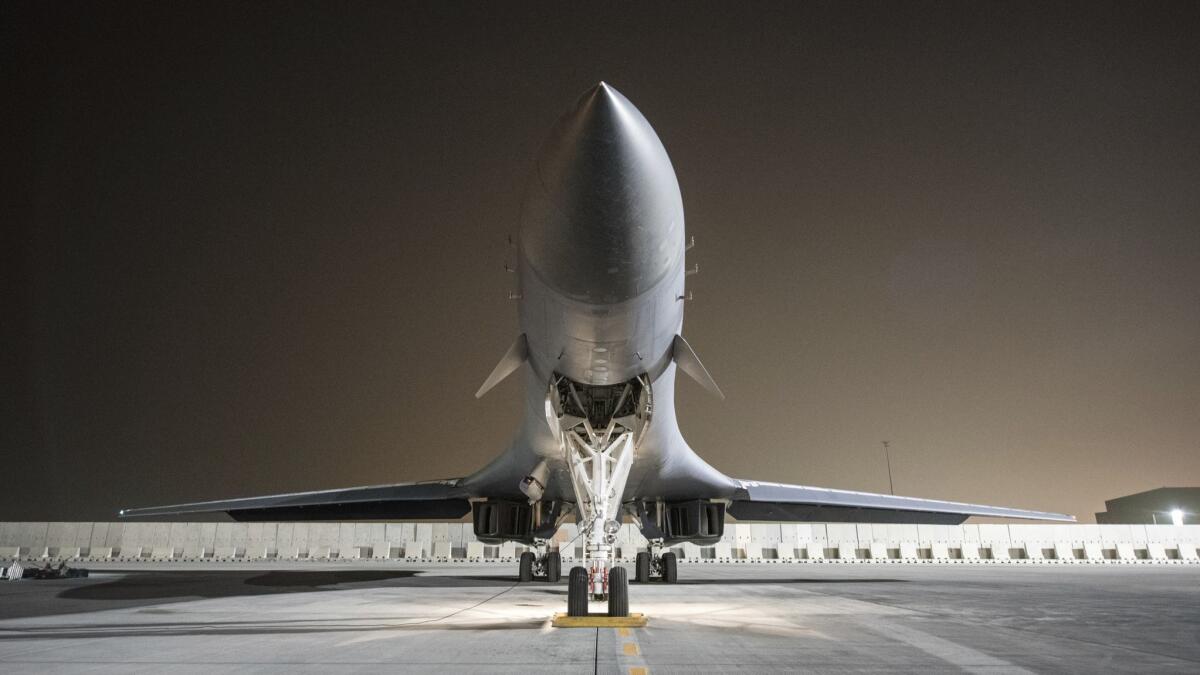Op-Ed: The new congressional authorization to fight terrorism still gives the president too much power

- Share via
This week, three Republicans and three Democrats on the Senate Foreign Relations Committee introduced a new authorization for the use of U.S. military force in what has become a never-ending war on terrorism. It aims to provide lawmakers with the ability to rein in the president’s power to deploy troops in what has become our forever war.
The current statutory authority, the Authorization for Use of Military Force, or AUMF, has been flexible to the point of absurdity. Passed a week after the 9/11 attacks, it authorized a conflict originally designed as a legitimate retaliatory campaign against Al Qaeda. Four presidencies later, we are fighting in multiple countries and across two continents against groups not even in existence when the 2001 resolution was written.
While congressional action on a new authorization is certainly warranted and welcome, the authorization released last week will do very little to address the problem of potential executive overreach. The draft AUMF, in fact, again provides the White House with a blank check, under a cloak of transparency and accountability.
If there is one lesson Congress should have learned in nearly two decades since the 2001 AUMF, it is that a sunset, or cut-off date, is an essential component in dealing with asymmetrical warfare and enemies. In its absence, the president is granted the ability to fight the war as long as he or she chooses. Indeed, the only way Congress can terminate a war in such a situation is by rescinding the authority altogether or cutting off appropriations — two possibilities that are fantastical in today’s political environment.
Unfortunately, the new authorization has no expiration date, an omission that will perpetuate the imbalance between the executive and legislative branches on matters of war and peace. And by leaving the date open-ended, it will be far easier for the war on terrorism to continue to spread to new territory.
In 2001, Congress wanted to ensure that the president had specific statutory authority to retaliate against Al Qaeda, perpetrator of the 9/11 attacks. As time as gone by, however, the executive branch has expanded the targets to include a long list of regional and local terrorist groups, from the Islamic State in Syria to Boko Haram in northern Nigeria.
The new AUMF not only codifies this expansive view, but does so in a way that makes a mockery of the goal of congressional oversight of war powers. It allows for the addition of “associated (or partner) forces” to the enemy roster, terms so ill-defined that the president, for all practical purposes, possesses unlimited power to bomb any terrorist group under the sun.
As valiant as the latest effort is, the Senate Foreign Relations Committee should start over.
For example, the White House could attack a faction of tribesmen in the middle of Africa if it determined they had even slight contact with Al Qaeda. Organizations with local objectives are lumped together with those that have transnational aims, a dangerous interpretation that would easily pave the way for a permanent, ever more global conflict against all terrorists at any time and at any place.
But the greatest weakness in the new AUMF is that it gets the entire process of authorizing the use of military force backward.
The “declare war” clause in the Constitution makes it clear that any president who believes it is necessary for the United States to go to war overseas must make the case to the American people’s elected representatives in Congress. Only after the legislative branch votes in favor of war can the commander in chief actually prosecute a conflict. The resolution offered by the Foreign Relations Committee inexplicably shreds this process for the sake of political convenience. Were the resolution to pass, the president could launch airstrikes or deploy American troops against a band of terrorists into another country without first gaining the legislative branch’s assent. Instead, Congress would have to decide whether the action was unnecessary after that action was already taken.
Even the transparency requirements of the resolution are inadequate. The president, for example, must report to Congress on “all organizations, persons, or forces” he or she determines are partners of Al Qaeda, the Islamic State or the Taliban 30 days after the AUMF becomes law. The White House then would be bound to inform Congress within 48 hours if, at a later date, a new terrorist group was designated. But only Congress and not the American people must be notified. Whether we will know who we are fighting and why is left entirely to our lawmakers’ discretion.
No draft authorization for the use of military force is perfect at first. If war resolutions were easy, a new one would already be in place. Yet the architects of the Constitution wisely believed that going to war should be a difficult decision. Sending U.S. service members into battle is the most serious vote a member of Congress will ever make. Engaging in the debate and getting the decision right is what we elect representatives to do.
As valiant as the latest effort is, the Senate Foreign Relations Committee should start over. The next attempt should clearly and explicitly define who the enemy is, set out specific geographic parameters as to where the U.S. military will fight and include a sunset date so the executive branch cannot extend the war on terrorism infinitely without getting the approval of Congress. Anything less would make the inequity between the executive and legislative branches worse, not better.
Daniel DePetris is a fellow at Defense Priorities. Twitter: @DanDePetris
Follow the Opinion section on Twitter @latimesopinion and Facebook
More to Read
A cure for the common opinion
Get thought-provoking perspectives with our weekly newsletter.
You may occasionally receive promotional content from the Los Angeles Times.









